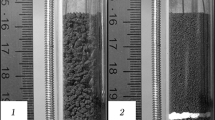Abstract
The combustion of granular powders is studied in a broad range of loading densities. The nontraditonal design of manometric bombs and the model ballistic installations on which the conditions close to a real detonation were simulated were used. It was established experimentally that the instability of a shot from a light–gas gun is caused by poor reproducibility of the ignition and combustion of powders fired at a loading density of Δ≲ 0.5 g/cm3. It is shown that the differences between the specific features of gas formation upon combustion of fine tubular and multiperforated powders under conditions of a classical manometric bomb (Δ≤ 0.3 g/cm3) and in a real shot (Δ≥ 0.6 g/cm3) are connected not only with the nonstationary character of combustion, but also with the dependence of the shape of a burning grain (area of the burning surface) on experimental conditions and, in particular, on the loadng density. It is shown that the use of a stepwise dependence of the factor in a geometrical law of combustion allows one to obtain a good agreement between the experimental and calculated pressure curves, including the ignition period, which makes it possible to describe the combustion of combined charges more correctly.
Similar content being viewed by others
REFERENCES
Ya. B. Zel'dovich, "Powder combustion at transient pressure," in: Theory of Combustion of Powders and Explosives [in Russian], Nauka, Moscow (1982), pp. 278-300.
Ya. B. Zel'dovich, "Theory of combustion of powders and explosives," ibid., pp. 49-86.
B. V. Novozhilov, Nonstationary Combustion of Solid Propellants [in Russian], Nauka, Moscow (1973).
Ya. B. Zel'dovich, O. I. Leipunskii, and V. B. Librovich, Theory of Nonstationary Combustion of a Powder [in Russian], Nauka, Moscow (1975).
Yu. A. Gostintsev, L. A. Sukhanov, and V. P. Pokhil, "Nonstationary processes upon combustion of a powder," in: Combustion and Explosion, Proc. of III All-Union Symp. on Combustion and Explosion [in Russian], Nauka, Moscow (1972), pp. 83-86.
I. G. Assovskii, "Theory of nonstationary combustion of a propellant at high pressure," Dokl. Akad. Nauk SSSR, 294, No. 1, 103-106 (1987).
Yu. F. Khristenko, "Experimental studies of the basic internal ballistic processes in light-gas guns," in: All-Siberia Readings on Mathematics and Mechanics, Proc. of the Int. Conf. [in Russian], Vol. 2, Izd. Tomsk. Univ., Tomsk (1997), pp. 114-122.
M. E. Serebryakov, Internal Ballistics [in Russian], Oborongiz, Moscow (1949).
D. W. Bogdanoff, "CFD modeling of bore erosion in two-stage gas guns," NASA Report No. TM-112236, August (1998).
H. L. Brode and J. Enstrom, "Internal ballistics, emergence of a ash and a foamy cloud," in: Numerical Modeling of Explosions [Russian translation], Mir, Moscow (1976), pp. 160-186.
V. K. Mar'in, V. P. Zelenskii, B. M. Orlov, et al., Powders, Solid Propellants, and Explosives [in Russian], Izd. Min. Oborony Ross. Fed., Moscow (1992).
O. I. Leipunskii, "Surface layer of a burning powder," in: Theory of Combustion of Powders and Explosives [in Russian], Nauka, Moscow (1982), pp. 301-305.
A. M. Zhilaev and S. V. Dudin, "Lagrange internal ballistic problem for the controlled rate of layer-bylayer burning of a powder," Fiz. Goreniya Vzryva, 30, No. 5, 78-84 (1994).
O. I. Leipunskii, A. A. Zenin, and V. M. Puchkov, Éffect of a catalyst on the characteristics of the combustion zone of a condensed substance," in: Combustion and Explosion: Proc. of III All-Union Symp. on Combustion and Explosion [in Russian], Nauka, Moscow (1972), pp. 74-81.
A. N. Ishchenko, Yu. P. Khomenko, and N. M. Samorokova, "Integrodifferential method of determining the laws of combustion of condensed systems under constant-volume conditions, " Fiz. Goreniya Vzryva, 35, No. 1, 67-71 (1999).
V. M. Kuvshinov, V. V. Sergeev, and M. I. Dubner, "Studies in the field of internal ballistics of domestic small-bore weapons," Boepripasy, Nos. 5 and 6, 22-26 (1995).
E. V. Zhalnin and Yu. F. Khristenko, "One method of improving the ballistic effciency of a powder charge," in: Mechanics of Flight Vehicles and Modern Materials [in Russian], Izd. Tomsk. Univ., Tomsk (1998), pp. 48-49.
V. V. Zharovtsev, L. V. Komarovskii, and E. I. Pogorelov, Mathematical Modeling and Optimum Design of Ballistic Installations [in Russian], Izd. Tomsk. Univ., Tomsk (1989).
S. A. Betekhtin, A. M. Vinitskii, M. S. Gorokhov, et al., Gas-Dynamic Fundamentals of Internal Ballistics [in Russian], Oborongiz, Moscow (1957).
Author information
Authors and Affiliations
Rights and permissions
About this article
Cite this article
Khristenko, Y.F. Experimental Methods for Studying the Combustion of Granular Powders in a Broad Range of Process Parameters. Combustion, Explosion, and Shock Waves 37, 72–77 (2001). https://doi.org/10.1023/A:1002872810296
Issue Date:
DOI: https://doi.org/10.1023/A:1002872810296



